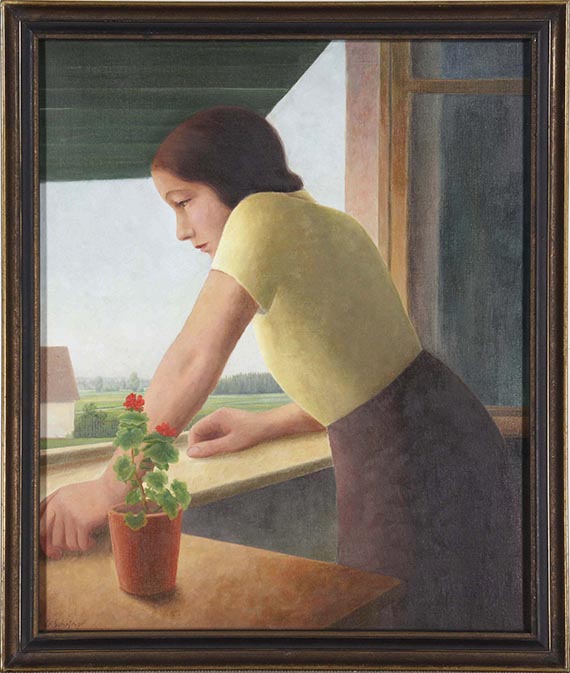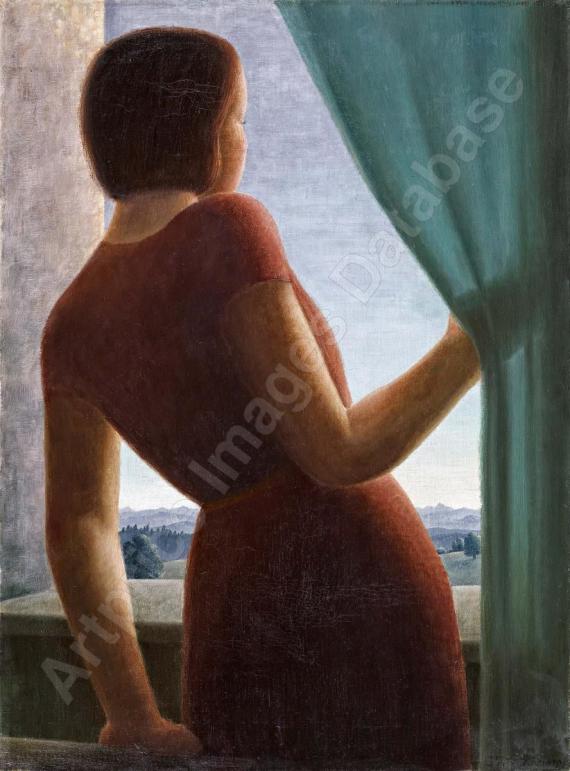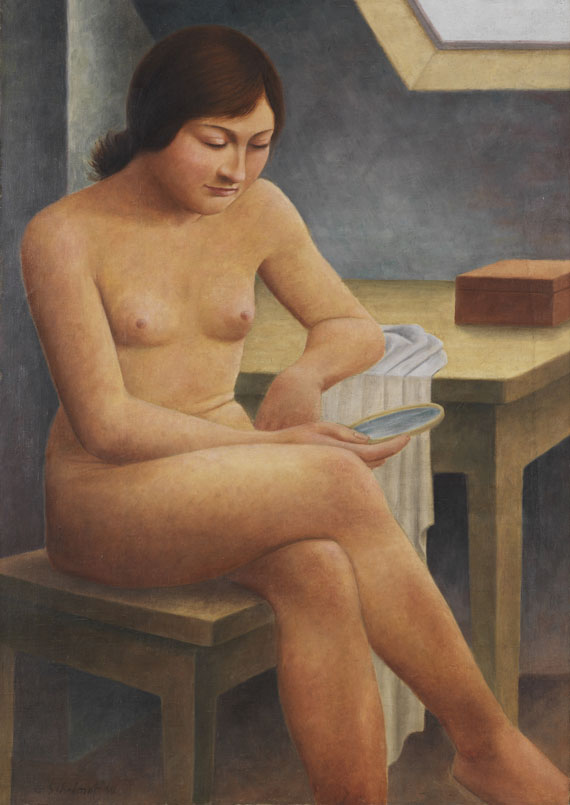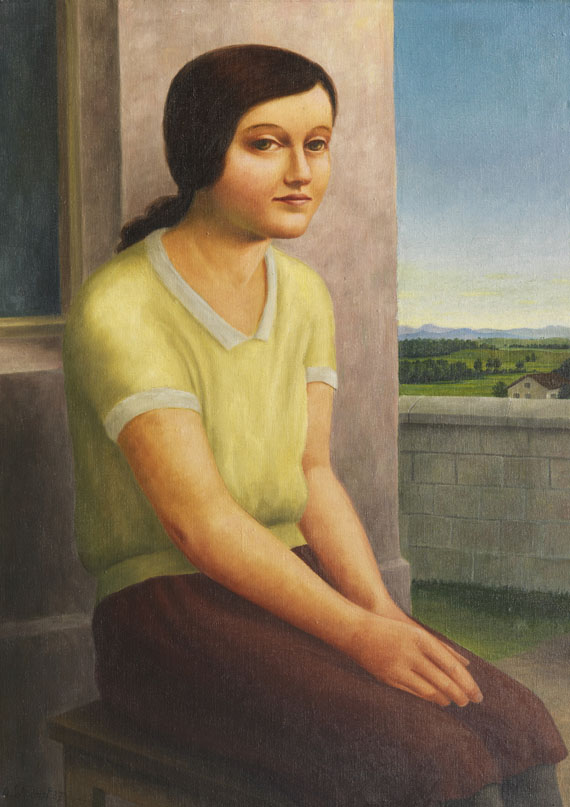237
Georg Schrimpf
Ausschauende, 1932.
Oil on canvas
Estimate:
€ 80,000 - 100,000
$ 88,000 - 110,000
Ausschauende. 1932.
Oil on canvas.
Signed and dated lower left. Stretcher inscribed by hand "Schrimpf Ausschauende 1932". 68 x 57 cm (26.7 x 22.4 in).
[SM].
• Alongside Max Beckmann, Alexander Kanoldt, Christian Schad and others, the artist appeared prominently in the formative exhibition "Deutsche Malerei seit dem Expressionismus. Die Neue Sachlichkeit" in Mannheim in 1925.
• Georg Schrimpf was undoubtedly one of the leading representatives of New Objectivity in the 1920s and 1930s.
• With his engrossed female figures and deserted landscapes, Schrimpf draws retrospectively on motifs from German Romanticism.
PROVENANCE: Graphisches Kabinett Günther Franke, Munich (with a label and the stamp on the stretcher).
Private collection, Munich.
Private collection, Southern Germany (inherited from the above).
EXHIBITION: Münchner Kunst. Sonderausstellung in der Neuen Pinakothek, January - February 1935, cat. no. 437 (fig. p. 31).
LITERATURE: Wolfgang Storch (ed.), Georg Schrimpf und Maria Uhden. Leben und Werk. Mit einem Werkverezcihnis von Karl Ludwig Hofmann und Christmut Praeger, Berlin 1985, cat. no. 1932/4.
Matthias Pförtner, Georg Schrimpf, Berlin 1940, fig. p. 39.
"What I have pursued for a long time is this: to be clear, simple and obvious."
Georg Schrimpf
Called up: December 7, 2024 - ca. 15.09 h +/- 20 min.
Oil on canvas.
Signed and dated lower left. Stretcher inscribed by hand "Schrimpf Ausschauende 1932". 68 x 57 cm (26.7 x 22.4 in).
[SM].
• Alongside Max Beckmann, Alexander Kanoldt, Christian Schad and others, the artist appeared prominently in the formative exhibition "Deutsche Malerei seit dem Expressionismus. Die Neue Sachlichkeit" in Mannheim in 1925.
• Georg Schrimpf was undoubtedly one of the leading representatives of New Objectivity in the 1920s and 1930s.
• With his engrossed female figures and deserted landscapes, Schrimpf draws retrospectively on motifs from German Romanticism.
PROVENANCE: Graphisches Kabinett Günther Franke, Munich (with a label and the stamp on the stretcher).
Private collection, Munich.
Private collection, Southern Germany (inherited from the above).
EXHIBITION: Münchner Kunst. Sonderausstellung in der Neuen Pinakothek, January - February 1935, cat. no. 437 (fig. p. 31).
LITERATURE: Wolfgang Storch (ed.), Georg Schrimpf und Maria Uhden. Leben und Werk. Mit einem Werkverezcihnis von Karl Ludwig Hofmann und Christmut Praeger, Berlin 1985, cat. no. 1932/4.
Matthias Pförtner, Georg Schrimpf, Berlin 1940, fig. p. 39.
"What I have pursued for a long time is this: to be clear, simple and obvious."
Georg Schrimpf
Called up: December 7, 2024 - ca. 15.09 h +/- 20 min.
Georg Schrimpf - A Master of Emotional Painting
Hardly any other artist knew how to charge his few subjects with as much melancholic emotions as Georg Schrimpf did. A loner like many of the writers of his time, such as Oskar Maria Graf, he succeeded, despite many political challenges as well as dramatic events in his private life, to place his work where it was best for his artistic progress, especially in the 1920s and 1930s. "This is most obvious in the case of Georg Schrimpf", reported the German journalist and writer Richard Bie (Biedrzynski) in 1930, "whose classic works mark the beginning of a line of German painters of the present age. Initially, Georg Schrimpf could be considered an opposition to a time of an impressionist taste in art. Impressionism was the reflection of a colorful world, a pathetic surface behind which nature was lost. [..] Accordingly, the mere denomination "Sachlichkeit" (Objectivity) must be rejected for Georg Schrimpf and the circle of contemporary German painters around him. For some time, New Objectivity thought of itself as a revolutionary movement. But it is everything but revolution, uprising, revolt, disorder. In its depth, it is the true discipline and natural destiny of man. [..] We have been rightly reminded that Georg Schrimpf’s pictures are modeled on the Cinquecento, the Italian painting of the sixteenth century, which testifies to the spiritual significance of these works. But the fact that Georg Schrimpf has nature for himself makes for his greatness." (Richard Bie, Der sachliche Kreis. Georg Schrimpf: from the volume "Deutsche Malerei der Gegenwart", Weimar 1930, p.10ff).
Formation towards "New Objectivity
With the attention of the Berlin art dealer Herwarth Walden, the artist, who was born in Munich in 1899, made a decisive step towards an increased recognition in 1916. His commitment to the artists' association "Novembergruppe", which was founded in Berlin in 1918 with the radical political aim to propagate a type of "new man" after the murderous war, gave his painting thre right impetus in the direction of "New Objectivity", a term that would only be coined in the description of Modernism in context of the legendary exhibition at the Mannheim Kunsthalle 1925. With his enraptured female figures and solitary landscapes, Schrimpf retrospectively drew on the Nazarenes, the romantic-religious movement of the early 19th century. German Romanticism, especially the figures of Otto Philipp Runges, also found their way into Schrimpf's painting, or the motif of the figure in back view, as we know it from Caspar David Friedrich and his 'famous' view through the open window, an intimate painterly motif of early Realism in Germany. Justus Bier, American art historian and director of the Kestner Gesellschaft in Hanover from 1930-1936, was in charge of the Kestner Gesellschaft's 126th exhibition in 1913: Neue deutsche Romantik. Alexander Kanoldt, Franz Radziwill, Georg Schrimpf, Albert Renger-Patzsch, and described the Romantic school of the early 19th century as their source of inspiration. "If Schrimpf says about his artistic intentions", Bier wrote, "that what I would like to do and have been pursuing for a long time is this: to be clear, simple, and unambiguous (and this includes the same human condition)', than this is a statement similar to what Runge or Friedrich might have done." (Justus Bier, in: Neue deutsche Romantik. 126th Exhibition of the Kestner- Gesellschaft, 1933)
Was Schrimpf a Romanticist?
Was Georg Schrimpf a romanticist in 1933? In 1925, the artist showed his works alongside artists such as Max Beckmann, Alexander Kanoldt and others at the Mannheim exhibition ‘Deutsche Malerei seit dem Expressionismus’. The director of the Mannheim Kunsthalle, Gustav F. Hartlaub, used the term "Neue Sachlichkeit" (New Objectivity) to describe the art of the Weimar Republic and also included various realist positions such as Verism and Classicism. The same year, Franz Roh, an art historian and artist living in Munich, made an alternative proposal. He published the book "Nach-Expressionismus - Magischer Realismus: Probleme der neuesten europäischen Malerei" (Post-Expressionism - Magic Realism: Problems of Latest European Painting), which addressed the development after the First World War. Roh did not find it easy to identify an all-encompassing label for the new tendencies: He discarded all the terms "Ideal Realism", "Verism” and "Neoclassicism" and made a chronological approach by using "Post-Expressionism". Finally, he also chose the difficult-to-define phrase "Magic Realism" to summarize the diversity of current figurative painting. However, by concentrating on representational positions, be they realistic or magical, a large part of the art of the time was excluded.
Silent Protest in Schrimpf's Best Pictures
In a text for a planned book about Georg Schrimpf in 1924, Franz Roh saw his pictures as an expression of an "idealism of goodness with a realism of conscientious experience. […] On the other hand, he never paints in front of the model, even if it is depicted with microscopic precision. Everything must emerge from memory, from the inner conception of forms, and starts to examine reality from there, but relentlessly and down to the smallest detail. Bad realism reproduces nature more than it produces it. Schrimpf's best pictures are silent protest on several levels: They want neither a naked, abstract order (Cubism), nor even a cosmic vortex (Futurism), nor to stick to object and matter (19th Century Realism). [..] Schrimpf's pictures create a deep peace between the two worlds, without trying to eradicate a delicate tension that should always remain between these spheres. [..] The stoic motionlessness of the more mature pictures proclaims that the beings do not fall into torment when they enter into these cool, delicately tense curves. Cubism was an initial source of inspiration for Schrimpf was initially. Furthermore, Italian painting up to Renaissance. But hardly Henri Rousseau, as much as he must be praised in many respects as the unconscious founder of New Objectivity." (Franz Roh, quoted from: Georg Schrimpf und Maria Uhden. Leben und Werk, Berlin 1985, pp. 142f.).
From New Objectivity to “Degenerate” Art
In 1932, Günther Franke ha a solo exhibition at the ‘Graphische Kabinett’, the first in Munich in ten years. The art historian and journalist Hans Eckstein noted in the magazine ‘Kunst und Künstler’: "Schrimpf has long enjoyed special recognition among the painters of so-called Neo-Romanticism - even more so in the north than in the south of Germany, where landscapes, people and way of life are closer in kind to artist and his work. This connection became even more visible after Schrimpf turned away from ‘Mannerism’, thereby sacrificing and becoming a victim of the expressionist art fashion. Today's Schrimpf is more genuine; indeed, he is completely real."
Georg Schrimpf was undoubtedly one of the leading representatives of New Objectivity in the 1920s and 1930s. He was regarded a protagonist of Verism and is mentioned in the same breath as artists such as Christian Schad and Georg Scholz. The National Socialists initially viewed Georg Schrimpf's work as a contemporary view of German Romanticism, but abandoned this positive assessment when the artist's 'red' past became known; Schrimpf was a member of the communist party KPD for a short time. His position as associate professor at the University of Art Education in Berlin, which he had only taken up in 1933, was also revoked. In 1937, his works were confiscated from museums as “degenerate” art. Georg Schrimpf died in Berlin on April 19, 1938. [MvL]
237
Georg Schrimpf
Ausschauende, 1932.
Oil on canvas
Estimate:
€ 80,000 - 100,000
$ 88,000 - 110,000
Buyer's premium and taxation for Georg Schrimpf "Ausschauende"
This lot can be purchased subject to differential or regular taxation.
Differential taxation:
Hammer price up to 800,000 €: herefrom 32 % premium.
The share of the hammer price exceeding 800,000 € is subject to a premium of 27 % and is added to the premium of the share of the hammer price up to 800,000 €.
The share of the hammer price exceeding 4,000,000 € is subject to a premium of 22 % and is added to the premium of the share of the hammer price up to 4,000,000 €.
The buyer's premium contains VAT, however, it is not shown.
Regular taxation:
Hammer price up to 800,000 €: herefrom 27 % premium.
The share of the hammer price exceeding 800,000 € is subject to a premium of 21% and is added to the premium of the share of the hammer price up to 800,000 €.
The share of the hammer price exceeding 4,000,000 € is subject to a premium of 15% and is added to the premium of the share of the hammer price up to 4,000,000 €.
The statutory VAT of currently 19 % is levied to the sum of hammer price and premium. As an exception, the reduced VAT of 7 % is added for printed books.
We kindly ask you to notify us before invoicing if you wish to be subject to regular taxation.
Differential taxation:
Hammer price up to 800,000 €: herefrom 32 % premium.
The share of the hammer price exceeding 800,000 € is subject to a premium of 27 % and is added to the premium of the share of the hammer price up to 800,000 €.
The share of the hammer price exceeding 4,000,000 € is subject to a premium of 22 % and is added to the premium of the share of the hammer price up to 4,000,000 €.
The buyer's premium contains VAT, however, it is not shown.
Regular taxation:
Hammer price up to 800,000 €: herefrom 27 % premium.
The share of the hammer price exceeding 800,000 € is subject to a premium of 21% and is added to the premium of the share of the hammer price up to 800,000 €.
The share of the hammer price exceeding 4,000,000 € is subject to a premium of 15% and is added to the premium of the share of the hammer price up to 4,000,000 €.
The statutory VAT of currently 19 % is levied to the sum of hammer price and premium. As an exception, the reduced VAT of 7 % is added for printed books.
We kindly ask you to notify us before invoicing if you wish to be subject to regular taxation.




 Lot 237
Lot 237 



